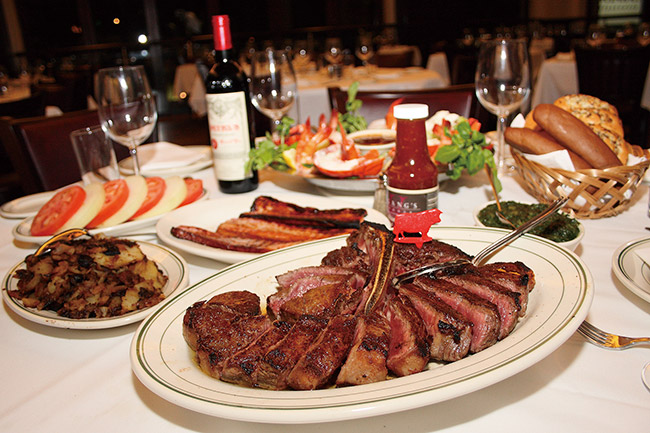
February 13, 2014
February Dining Tips
Originally published on metropolis.co.jp on February 2014 Meat-eaters will want to check out Wolfgang’s Steakhouse in Roppongi. This New York steakhouse’s first international restaurant serves up USDA prime beef that is aged in house. The menu includes steakhouse staples like crab cakes, shrimp cocktail, and creamed spinach. New world wine lovers will appreciate the deep […]
By Metropolis
Originally published on metropolis.co.jp on February 2014

Meat-eaters will want to check out Wolfgang’s Steakhouse in Roppongi. This New York steakhouse’s first international restaurant serves up USDA prime beef that is aged in house. The menu includes steakhouse staples like crab cakes, shrimp cocktail, and creamed spinach. New world wine lovers will appreciate the deep list of California cabernet sauvignons. 1F Roppongi Duplex M’s Bldg, 5-16-50 Roppongi, Minato-ku
Italian chef Daniele Cason is making a unique pizza alla pala, a crispy crust pizza at The Pizza Bar on 38th at the Mandarin Oriental Hotel. Highlights include a five-cheese pizza and a trappizino of marscapone and truffles. Nihonbashi-Muromachi 2-1-1, Chuo-ku
Star chef Yoshihiro Narisawa has collaborated with the historic Toyoken restaurant to update its menu with a healthful and upscale twist at Tokyo Toyoken. Top quality ingredients like Matsuzaka wagyū is used for the menchi katsu and the black curry rice. 1F Akasaka K Tower Bldg, 1-2-7 Moto-Akasaka, Minato-ku
Maui Mike’s fire-roasted rotisserie chicken from Oahu, Hawaii to Tokyo. Select from seven sauces, including smoky BBQ or yuzu pepper and get a bottle of Hawaiian beer to wash down the chicken. 5-32-13 Hakusan, Bunkyo-ku
Atre Ebisu 3rd floor has completed a renovation. Historic wagashi shops Kyo Hayashiya from Kyoto and Nihonbashi Eitaro from Tokyo offer up wagashi confectionaries like with matcha warabi mocha and modern versions like dorayaki (pancakes with azuki) but with whipped cream. There is a new Dean & Deluca as well as Sushi Deli Matsue, a local sushi-ya with 47 years of history.
Warm up with a hot smoothie the next time you are at Tokyo Station. Fico & Pomum has four types of hot smoothies such as apple cinnamon and tomato almond. 17F Grand Tokyo North Tower, 1-9-1 Marunouchi, Chiyoda-ku. Open weekdays only.
Ark Hills South Tower at Roppongi Itchome has opened with a well-stocked gourmet supermarket, Fukushimaya and The Cellar wine shop. The 3rd Burger for Australian beef hamburgers and organic vegetable toppings. Chateau Mercian Tokyo Guest Bar is the ideal spot to try a variety of Japanese wines with oysters, grilled meat, and foie gras.
New York’s City Bakery, a classic café created by Maury Rubin, has opened in Shinagawa and Hiroo. The shop is famous for it’s pretzel croissants, muffins, brownies and cookies as well as hot chocolate with marshmallows. 2F Atre Shinagawa, 2-18-1 Konan, Minato-ku; 1F Hiroo Yutaka Towers, 5-24-1 Hiroo, Shibuya-ku
Gontran Cherrier has opened Table Convivale Shibuya in the basement of his eponymous bakery. Serving wine and Alsatian dishes like baeckeoffe, a hearty stew of beef, pork, duck, and potatoes and tarte flambé. 1-14-11 Shibuya, Shibuya-ku
Settle in at Ginza Maru for a value-priced washoku lunch set starting at ¥1,000. Currently serving grilled fish, simmered pork, or chicken sukiyaki. 6-12-15 Ginza, Chuo-ku
Yuu is a basement yakitori-ya has a nice selection of sake, including many from Tochigi prefecture, chef Tagami’s home prefecture. It’s a small restaurant so call ahead and reserve seats. B1 SKB Bldg, 1-9-5 Iidabashi, Chiyoda-ku; Tel: 03-3221-1344
Mt. Fuji is finding its way onto many tableware items like sake cups and dishes. This three-dimensional ginger grater, Fuji-san oroshi, is not only cute, it actually will grind up the rhizome. With the cold weather, grinding some ginger or turmeric, or both, for your tea is a natural way to fight off infections.
We have yet to try, but can’t wait to get our hands on awajōyu. It’s soy sauce in a foam version, created by maiko in Kyoto. The classic example of omotenashi, this mousse-like condiment is hard to spill and easy to eat. You have to love the ingenuity.
Restaurants featuring regional foods continue to open up. One of our new favorites is Yamagata Sakanaichi at Tokyo Station. With over 150 ji-zake, it’s possible to do a nomi kuraberu (taste comparison) of different sake. B1 Tokyo Station Grand Roof, 1-9-1 Marunouchi, Chiyoda-ku
Anago-ya Ginza Hirai specializes in the young version of the sea eel, usually never longer than 35 cm. The tender anago has a very thin skin and the meat will melt in your mouth. Try both the simmered and grilled versions served in a lacquer box over rice. 5-9-5 Ginza, Chuo-ku
Loving the offerings of granola from shops like Hudson Market Bakers (1-8-6 Azabu-Juban, Minato-ku). Ganori (1-25-11 Uehara, Shibuya-ku) offers up some unique local flavors like Japanese Purple Potatoes and Japanese Gobo Mix.
Beer and Wine 65 Rokugo near Kanda station has more than 200 types of international beers as well as 100 different wines. The food menu includes pizza, pasta and 20 types of cheese. 2F Okuno Pia, 1-3-7 Kajicho, Chiyoda-ku
On our radar to check out in the new year is bird西男man, a jidori (regional chicken) specialty restaurant showcasing Miyazaki poultry. A great selection of shochu to pair with the smoky charcoal-grilled chicken, deep-fried chicken wings and chicken skin with a leek and ponzu dressing. 7-5-7 Roppongi, Minato-ku
Washoku being declared an Intangible Cultural Heritage by UNESCO has opened the doors to foreign chefs wanting to study traditional Japanese cuisine. Foreigners who graduate from a Japanese culinary school will now be able to stay in Japan to continue their training at a Japanese restaurant.







